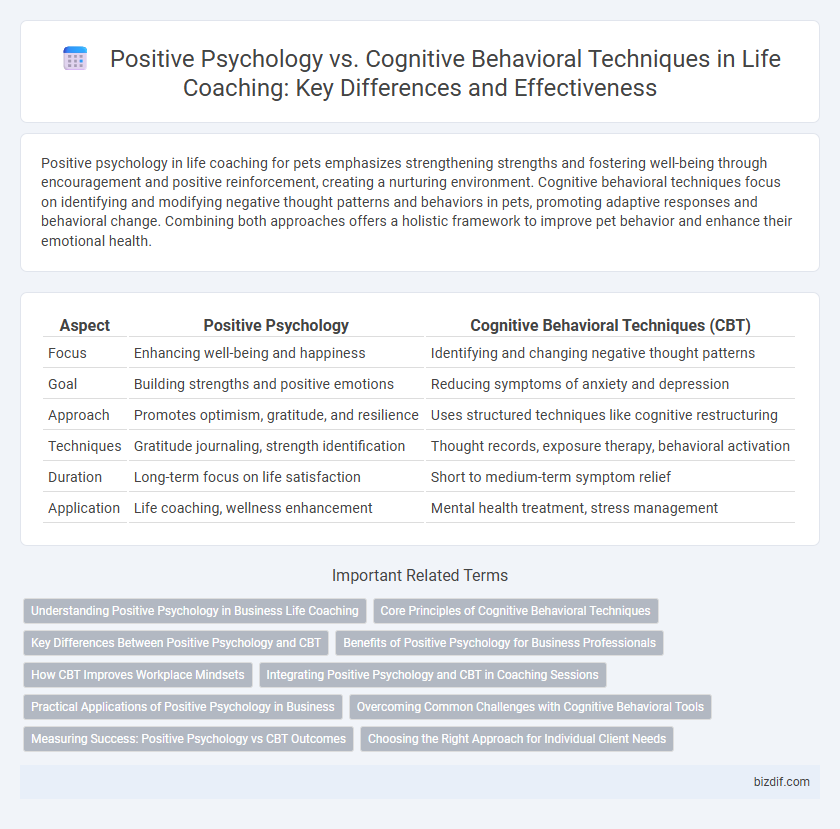Positive psychology in life coaching for pets emphasizes strengthening strengths and fostering well-being through encouragement and positive reinforcement, creating a nurturing environment. Cognitive behavioral techniques focus on identifying and modifying negative thought patterns and behaviors in pets, promoting adaptive responses and behavioral change. Combining both approaches offers a holistic framework to improve pet behavior and enhance their emotional health.
Table of Comparison
| Aspect | Positive Psychology | Cognitive Behavioral Techniques (CBT) |
|---|---|---|
| Focus | Enhancing well-being and happiness | Identifying and changing negative thought patterns |
| Goal | Building strengths and positive emotions | Reducing symptoms of anxiety and depression |
| Approach | Promotes optimism, gratitude, and resilience | Uses structured techniques like cognitive restructuring |
| Techniques | Gratitude journaling, strength identification | Thought records, exposure therapy, behavioral activation |
| Duration | Long-term focus on life satisfaction | Short to medium-term symptom relief |
| Application | Life coaching, wellness enhancement | Mental health treatment, stress management |
Understanding Positive Psychology in Business Life Coaching
Positive Psychology in business life coaching emphasizes strengths, resilience, and well-being to enhance employee performance and workplace satisfaction. Techniques include fostering gratitude, optimism, and flow to boost motivation and engagement, contrasting with Cognitive Behavioral Techniques that address negative thought patterns and behavior change. Incorporating Positive Psychology creates a proactive environment that promotes sustained productivity and organizational growth.
Core Principles of Cognitive Behavioral Techniques
Cognitive Behavioral Techniques (CBT) center on identifying and restructuring negative thought patterns to alter behavior and emotional responses effectively. Core principles include the collaboration between coach and client to set specific goals, employing cognitive restructuring to challenge unhelpful beliefs, and using behavioral experiments to reinforce adaptive changes. These techniques emphasize present-focused problem-solving and skill-building to foster lasting psychological resilience and improved mental health outcomes.
Key Differences Between Positive Psychology and CBT
Positive Psychology centers on enhancing well-being by cultivating strengths, gratitude, and optimism, while Cognitive Behavioral Techniques (CBT) focus on identifying and restructuring negative thought patterns and behaviors to alleviate psychological distress. Positive Psychology employs interventions like gratitude journaling and strength-based exercises to build resilience and happiness, contrasting with CBT's structured, problem-solving approach using cognitive restructuring and behavioral activation. Both approaches aim to improve mental health, but Positive Psychology emphasizes flourishing and growth, whereas CBT targets symptom reduction and coping skills.
Benefits of Positive Psychology for Business Professionals
Positive Psychology enhances business professionals' resilience and overall well-being by fostering strengths, gratitude, and optimism, which improve workplace engagement and productivity. Its focus on cultivating positive emotions and meaningful relationships leads to better stress management and increased job satisfaction. By integrating Positive Psychology, organizations can create supportive cultures that drive innovation and employee retention.
How CBT Improves Workplace Mindsets
Cognitive Behavioral Techniques (CBT) enhance workplace mindsets by identifying and restructuring negative thought patterns that hinder productivity and collaboration. Through CBT, employees develop practical strategies to manage stress, increase emotional resilience, and foster a problem-solving attitude. This approach complements positive psychology by providing actionable tools that transform optimistic outlooks into consistent, workplace-ready behaviors.
Integrating Positive Psychology and CBT in Coaching Sessions
Integrating Positive Psychology and Cognitive Behavioral Techniques in coaching sessions enhances client outcomes by combining strengths-based approaches with practical behavior change strategies. Positive Psychology focuses on building optimism, resilience, and well-being, while CBT targets maladaptive thoughts and promotes healthier cognitive patterns. Using this integration, coaches facilitate lasting transformation by fostering positive emotions alongside effective problem-solving skills.
Practical Applications of Positive Psychology in Business
Positive psychology in business emphasizes strengths, well-being, and resilience to enhance employee engagement, productivity, and organizational culture. Techniques such as gratitude exercises, strengths assessments, and mindfulness practices foster positive work environments and reduce burnout. Integrating these approaches with cognitive behavioral techniques can create comprehensive strategies for improving mental health and performance in corporate settings.
Overcoming Common Challenges with Cognitive Behavioral Tools
Cognitive Behavioral Techniques (CBT) provide practical tools for overcoming common challenges such as anxiety, negative thinking, and self-doubt by promoting structured cognitive restructuring and behavior modification. Positive Psychology complements CBT by fostering resilience, gratitude, and optimism, enhancing overall well-being. Integrating CBT with Positive Psychology strategies empowers life coaching clients to achieve lasting mental clarity and emotional balance.
Measuring Success: Positive Psychology vs CBT Outcomes
Measuring success in life coaching reveals distinct outcomes between Positive Psychology and Cognitive Behavioral Techniques (CBT). Positive Psychology emphasizes enhancing well-being and life satisfaction through strengths and gratitude exercises, often tracked using subjective happiness scales and resilience metrics. In contrast, CBT focuses on reducing symptoms of anxiety and depression by modifying dysfunctional thoughts, with effectiveness commonly evaluated through standardized clinical assessments and cognitive restructuring progress.
Choosing the Right Approach for Individual Client Needs
Positive psychology emphasizes building strengths and fostering well-being through techniques like gratitude journaling and visualization, ideal for clients seeking long-term fulfillment and resilience. Cognitive Behavioral Techniques (CBT) target specific thought patterns and behaviors, proving effective for clients needing practical strategies to manage anxiety, depression, or negative beliefs. Tailoring the approach requires evaluating client goals, emotional state, and cognitive readiness to balance empowerment with actionable change.
Positive Psychology vs Cognitive Behavioral Techniques Infographic

 bizdif.com
bizdif.com